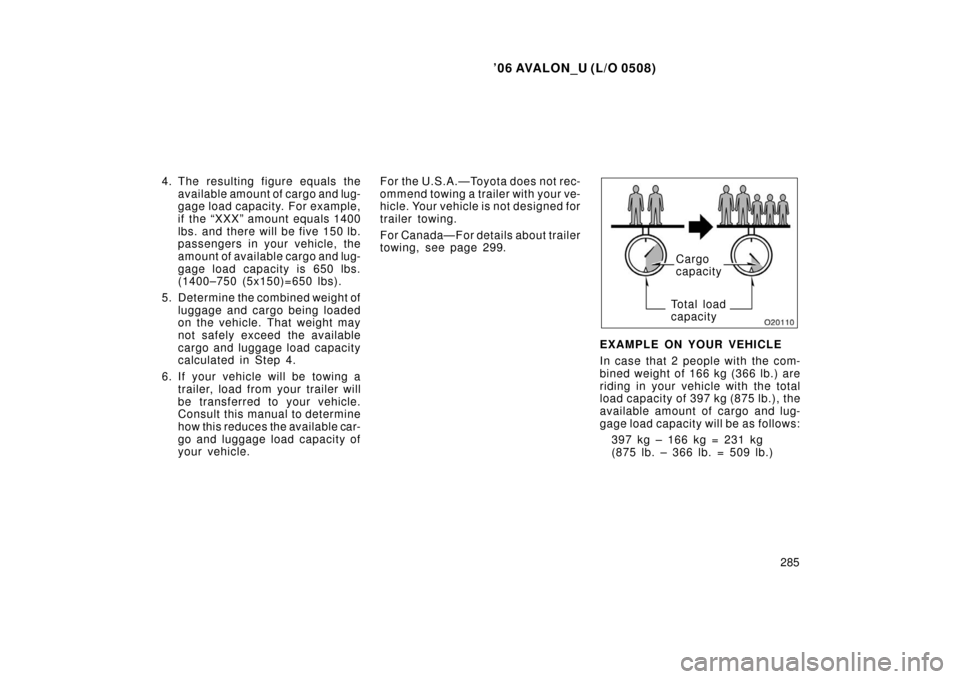Page 291 of 398

’06 AVALON_U (L/O 0508)
283
Vehicle load limits include total load
capacity, seating capacity, towing ca-
pacity and cargo capacity. Follow the
load limits shown below. Total load ca-
pacity and seating capacity are also
described on the tire and loading in-
formation label. For location of the tire
and loading information label, see
“Checking tire infl
at ion pr es s ur e” on
page 355.
Total load capacity:
397 kg (875 lb.)
Total load capacity means combined
weight of occupants, cargo and lug-
gage. Tongue load is included when
trailer towing. Seating capacity:
Total 5 (Front 2, Rear 3)
Seating capacity means the maximum
number of occupants whose esti-
mated average weight is 68 kg (150
lb.) per person. Depending on the
weight of each person, the seating ca-
pacity given may exceed the total
load capacity.
NOTICE
Even if the number of occupants
are within the seating capacity,
do not exceed the total load ca-
pacity.
Towing capacity: 454 kg (1000 lb.)
Towing capacity means the maxi-
mum gross trailer weight (trailer
weight plus its cargo weight) that
your vehicle is able to tow.
Cargo capacity
Cargo capacity may increase or de-
crease depending on the size (weight)
and the number of occupants. For de-
tails, see “—Capacity and distribu-
tion” that follows.
CAUTION
Do not apply the load more than
each load limit. That may cause
not only damage to the tires, but
also deterioration to the steering
ability and braking ability, which
may cause an accident.
Veh icle lo ad limit s
Page 292 of 398

’06 AVALON_U (L/O 0508)
284 When stowing cargo and luggage in
the vehicle, observe the following:� Put cargo and luggage in the trunk
when at all possible. Be sure all
items are secured in place.
� Be careful to keep the vehicle bal-
anced. Locating the weight as far
forward as possible helps maintain
balance.
� For better fuel economy, do not
carry unneeded weight.
CAUTION
�Do not place anything on the
package tray behind the rear
seatback. Such items may be
thrown about and possibly in-
jure people in the vehicle dur-
ing sudden braking or an acci-
dent.
�Do not drive with objects left
on top of the instrument panel.
They may interfere with the
driver’s field of view. Or they
may move during sharp vehicle
acceleration or turning, and im-
pair the driver’s control of the
vehicle. In an accident they
may injure the vehicle occu-
pants.Cargo capacity depends on the to-
tal weight of the occupants.
(Cargo capacity) = (Total load capac-
ity) – (Total weight of occupants)
STEPS FOR DETERMINING
CORRECT LOAD LIMIT
1. Locate the statement “The com- bined weight of occupants and
cargo should never exceed XXX
pounds” on your vehicle’s placard.
2. Determine the combined weight of the driver and passengers that will
be riding in your vehicle.
3. Subtract the combined weight of the driver and passengers from
XXX kilograms or XXX pounds.
Cargo and luggage—
—Stowage precautions —Capacity and distribution
Page 293 of 398

’06 AVALON_U (L/O 0508)
285
4. The resulting figure equals the
available amount of cargo and lug-
gage load capacity. For example,
if the “XXX” am ount equals 1400
lbs. and there will be five 150 lb.
passengers in your vehicle, the
amount of available cargo and lug-
gage load capacity is 650 lbs.
(1400–750 (5x150)=650 lbs).
5. Determine the combined weight of luggage and cargo being loaded
on the vehicle. That weight may
not safely exceed the available
cargo and luggage load capacity
calculated in Step 4.
6. If your vehicle will be towing a trailer, load from your trailer will
be transferred to your vehicle.
Consult this manual to determine
how this reduces the available car-
go and luggage load capacity of
your vehicle. For the U.S.A.—Toyota does not rec-
ommend towing a trailer with your ve-
hicle. Your vehicle is not designed for
trailer towing.
For Canada—For details about trailer
towing, see page 299.
Cargo
capacity
Total load
capacity
EXAMPLE ON YOUR VEHICLE
In case that 2 people with the com-
bined weight of 166 kg (366 lb.) are
riding in your vehicle with the total
load capacity of 397 kg (875 lb.), the
available amount of cargo and lug-
gage load capacity will be as follows: 397 kg – 166 kg = 231 kg
( 875 lb. – 366 lb. = 509 lb. )
Page 384 of 398
’06 AVALON_U (L/O 0508)
376
Model:2GR −FE
Type: 6 cylinder V type 4 cycle, gasoline
Bore and stroke, mm (in.): 94.0 �83.0 (3.70 �3.27)
Displacement, cm
3 (cu. in.):
3456 (210.9)
Overall length mm (in.) 5010 (197.2)
Overall width mm (in.) 1850 (72.8)
Overall height∗mm (in.) 1485 (58.5)
Wheelbase mm (in.) 2820 (111.0)
Front treadmm (in.) 1581 (62.2)
Rear treadmm (in.) 1570 (61.8)
∗: Unladen vehicle
Vehicle capacity weight (occupants + luggage) kg (lb.) 397 (875)
Towing capacity (trailer weight + cargo weight) kg (lb.) 454 (1000)
Dimensions and weights Engine